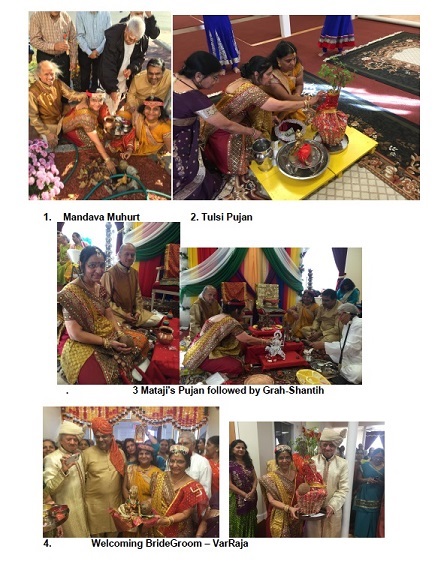
Archives
Contribute
| Tulsi Vivah At Satsang Center |
Pankajben Niranjanbhai Patel & Sudhir Parikh
11/17/2016
It was a day event, which began at 11 am with Ganesh Puja, Mandap Sthapan, Gruhshanti, and Pithi. There was an hour lunch break. Famous, Gujarati, tasty Khitchu was served . The afternoon session began at 2 pm with Dulha, Lord Krishna's arrival at gate with grand procession, followed by wedding ceremony done with all traditional rituals including Garland exchange, Hast Milap, Mangal Fera, SaptaPadi - Seven steps etc. Finally at 4:30 pm, the event concluded with Arati, Ras Garba, and delicious dinner. All the attendees were very happy to get blessings from Lord Krishna & Vrinda. . Main course of Dinner, like Gulab-Jamun, Samosa & Chhole were - prepared by AshokKumar (Punjabi) Family. Mango Lassi was served after the Wedding Procession. Rest of the dinner, traditional Daal, Bhaat, Shaak (Ringana-Bataka & Peas, was prepared by lovely SATSANG Sevaks and Sevikas with lots of Love!
SATSANG Center has been celebrating Tulsi-Vivah for last seventeen years and appreciates all the sponsors and participants of this program. This year, Tulsiji was sponsored by Niru Sudhir Parikh and Lalji , by Diptiben Devendrabhai Patel.
Tulsi Vivah is the ceremonial marriage of the Tulsiji (plant - holy basil) to the Lord Vishnu's Avatar Krishna. This ceremony can be performed any time between Prabodhini Ekadashi - the eleventh lunar day of the bright fortnight of the Hindu month Kartik to the full moon of the month (Kartik Poornima – also known as Dev-Diwali). Usually it is performed on the eleventh or the twelfth lunar day, but in USA on Sat or Sunday between Ekadashi & Purnima. The Tulsi wedding signifies the end of the monsoon and the beginning of the Hindu wedding season.
You may also access this article through our web-site http://www.lokvani.com/
.jpg)
.jpg)
